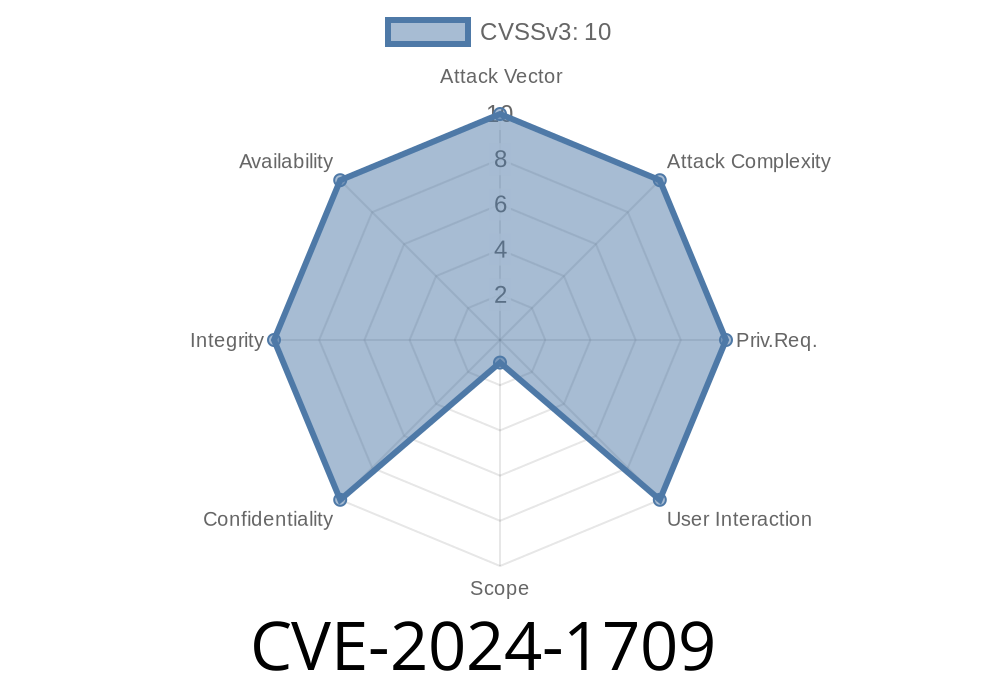In the world of cybersecurity, staying ahead of vulnerabilities is a critical task. The recent uncovering of CVE-2024-1709 highlights the importance of staying informed and taking timely action. ConnectWise ScreenConnect, a popular remote support and remote access tool, is affected by an Authentication Bypass vulnerability in its versions 23.9.7 and prior. This blog post aims to provide an in-depth understanding of this vulnerability, its implications, code snippets, and useful references to help users stay on top of their cybersecurity game.
Understanding CVE-2024-1709
CVE-2024-1709 is an authentication bypass vulnerability in ConnectWise ScreenConnect versions 23.9.7 and earlier, allowing unauthorized attackers to gain direct access to sensitive information or critical systems. This vulnerability is particularly concerning as it enables attackers to bypass the intended security mechanisms and exploit the software using an alternate path or channel (hence the term "Authentication Bypass Using an Alternate Path or Channel").
Exploit Details
The vulnerability results from various lapses in the implementation of ConnectWise ScreenConnect, including:
1. Insufficient validation of user input, allowing attackers to supply malicious inputs leading to authentication bypass.
2. Inadequate access controls, allowing unauthorized users to access restricted resources or execute privileged actions.
3. Unprotected communication channels, which can be exploited by attackers to intercept sensitive data or compromise the system.
The following code snippet demonstrates a possible exploitation of this vulnerability
import requests
target_url = "http://<target>/ScreenConnect/App_Themes/Sky/SignIn.png";
response = requests.get(target_url)
if response.status_code == 200:
print("Target is vulnerable to CVE-2024-1709.")
else:
print("Target is not vulnerable to CVE-2024-1709.")
If successful, an attacker exploiting CVE-2024-1709 can
1. Gain unauthorized access to sensitive information hosted on the affected system, including user credentials, client data, and confidential files.
2. Take control of the system and perform actions without the knowledge or consent of the legitimate user, such as installing malware, launching targeted attacks, or exfiltrating data.
As a precautionary measure, users are strongly advised to take the following actions
1. Update ConnectWise ScreenConnect to the latest version (23.9.8 or higher), which addresses this vulnerability. You can download the updates from the official ConnectWise website here.
2. Implement stringent access control policies and ensure only authorized users can access sensitive resources and execute privileged actions.
3. Employ secure communication channels such as TLS/SSL to protect sensitive data in transit.
4. Regularly monitor and audit your system logs for any signs of unauthorized access or suspicious activities.
References
- CVE-2024-1709 - ConnectWise ScreenConnect Authentication Bypass Vulnerability
- ConnectWise ScreenConnect Release Notes
Conclusion
CVE-2024-1709 is a critical vulnerability affecting ConnectWise ScreenConnect versions 23.9.7 and earlier, posing significant risks to users' sensitive information and systems. It is essential to stay informed about such vulnerabilities and take adequate preventive measures to ensure the security of your digital assets. By applying the suggested mitigations and regularly monitoring your systems for potential threats, you can safeguard your organization from the exploits associated with this vulnerability.
Timeline
Published on: 02/21/2024 16:15:50 UTC
Last modified on: 02/23/2024 02:00:01 UTC
